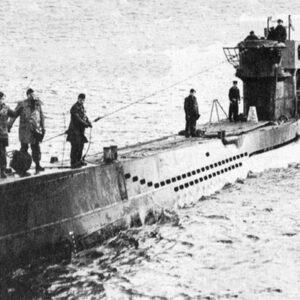When you’ve gotta go, you’ve gotta go. Even when you’re 200 feet underwater.
But 76 years ago, answering nature’s call actually sent a submarine to the bottom of the ocean.
Submersibles have been destroyed a host of ways over the years. Depth charges, naval and aerial bombings, collisions, even mechanical troubles have all dispatched them to Davy Jones’ Locker.
But only one holds the, err, distinction of being done in by its own potty.
U-1206 was the pride of Nazi Germany’s navy when she went into service in March 1944. Some 50 officers and men were assigned to her as she set out to attack Allied shipping.
Daily life aboard a U-boat was rough. They were built for combat performance, not comfort. Crewmen made their way around machinery and weaponry as best they could for months at a time. The food was bad, the air was stale and smelled of diesel exhaust fumes and guys who had gone too long without showering.
Then there was the matter of the “head,” naval slang for the bathroom. U-boats had only two – and one was often used to store extra food for the long undersea voyages. That’s right, all 50 men had to share one–and only one–restroom.
But U-1206 boasted a creature comfort most other submarines didn’t have: A state-of-the-art high-pressure toilet that could be flushed while submerged at great depths. That was very important because when 50 guys are using the same facility, you want all the flushing you can get.
Without going into technobabble, the pressure system was extremely complex. Leave it to the Germans to devise a flushing mechanism that was so complicated, an engineer “specialist” had to be present every time it was used.
And it worked well … until Saturday, April 14, 1945.
U-1206 had left occupied Norway eight days earlier and was cruising off the Scottish coast when something happened. Kapitänleutnant Karl Adolf Schlitt (you have to be very careful pronouncing that name when you telling this story) was commanding a U-Boat for the very first time. Naturally, that would drive up a man’s sense of self-importance.
But it’s possible Schlitt may have carried cockiness a bit too far because there are different versions of what happened next.
The skipper’s official report says the intricate water pressure system sprang a leak. It leaked alright. But the crew told a completely different story.
They said Captain Schlitt had an inflated view of his mechanical competence. He didn’t need any “specialist” to tell him how to work the new-fangled system. He could read the manual and make it flush all by himself.
Except, he couldn’t.
When he pulled the chain, the sub began filling with water from the ocean combined with raw sewage from its storage compartment. Talk about a mess! Schlitt cried for help. But nobody could figure out how how to stop the rapidly spreading slop.
It eventually reached the U-boat’s batteries. Saltwater and battery acid combined to create dangerous chlorine gas (one of several gases that had been used in World War I’s deadly trench attacks).
With toxic fumes quickly filling the boat, Schlitt had no choice but to order U-1206 to surface and open the hatch. Which is the most dangerous thing a submarine can do in wartime.
It didn’t take the Brits long to spot the sub and attack her from the air. One crew member was killed, and U-1206 was so badly damaged she couldn’t dive. So Schlitt had her scuttled and then gave the order to abandon ship.
Three men drowned during the evacuation. Nearby British ships picked up 36 others. The remaining 10 made it to shore in a lifeboat and were quickly captured.
In a way, U-1206’s demise was a fitting metaphor for its homeland’s sinking condition, because Nazi Germany was also going down the drain at the time. Within a fortnight, Hitler fired a bullet into his brain; the Third Reich went out of business a week later.
Nobody knows what happened to the skipper after the war. Schlitt slunk home in shame and disappeared from history.
Divers working on a pipeline stumbled upon the U-boat’s remains in the 1970s. She sits silently rusting on the bottom of the sea today, the only submarine ever sunk because someone had to use the facilities.

